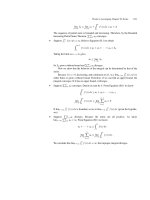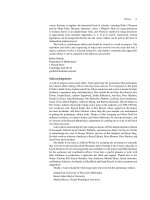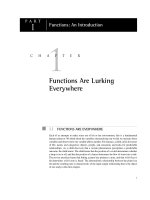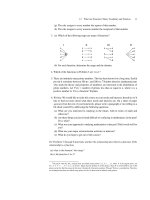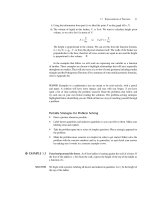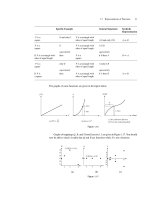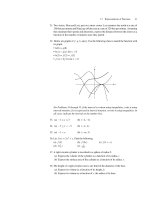Calculus: An Integrated Approach to Functions and their Rates of Change, Preliminary Edition Part 18 ppsx
Bạn đang xem bản rút gọn của tài liệu. Xem và tải ngay bản đầy đủ của tài liệu tại đây (235.36 KB, 10 trang )
4.2 Linear Functions 151
plays the role of y.
m =
velocity
time
=
v
T
− v
0
T − 0
=
1
T
(v
T
− v
0
)
The v-intercept is v
0
,sob=v
0
.
v(t) =
v
T
− v
0
T
t + v
0
.
(b) Acceleration =
v
t
=
v
T
−v
0
T
.
The horse’s acceleration is constant on [0, T ].
PROBLEMS FOR SECTION 4.2
1. The graph of f is given in the figure below.
B
C
D
E
y=f(x)
x
y
bc ed
A
Lines L
1
, L
2
, and L
3
are as shown. L
1
is horizontal and L
3
is vertical. A, B, C, D,
and E are points on the graph of f . Express your answers to the following questions
in terms of b, c, d, e, and the function f .
B
A
C
D
E
y=f(x)
x
y
bc e
1
3
2
d
(a) Write the coordinates of points A, B, C, D, and E using functional notation. For
instance, point A has coordinates (0, f(0)).
152 CHAPTER 4 Linearity and Local Linearity
(b) What is the slope of L
1
?
(c) What is the equation of L
1
?
(d) What is the length of the line segment joining point B and (b,0)?
(e) What is the length of the line segment joining points B and D?
(f) What is the slope of L
2
?
(g) What is the equation of L
2
?
(h) What is the equation of L
3
?
(i) What is the slope of the line L
3
?
2. Find the slope of the line through the two points given.
(a) (3, −1), (−2, −3)
(b) (π,2π), (0, −π)
(c) (
√
2, 3), (
√
2, 5)
(d) (
√
2,
√
3), (1,
√
3)
3. On the same set of axes, sketch lines through point (0, 1) with the slopes indicated.
Label the lines.
(a) slope = 0
(b) slope =
1
2
(c) slope = 1
(d) slope = 2
(e) slope = −
1
2
(f) slope = −1
(g) slope = −2
For Problems 4 through 13, find the equation of the line with the given characteristics.
4. Slope −
1
2
, passing through (−2, −3)
5. Slope π, passing through (3, 5)
6. Passing through points (0, a) and (b,0)
7. Passing through points (π,3)and (−π,5)
8. Passing through point (
√
3,
√
2) and parallel to 3x − 4y = 7
9. Passing through the origin and perpendicular to πx −
√
3y = 12
10. x-intercept of
√
π and parallel to the y-axis
11. Perpendicular to y − π = π(x −1) with a y-intercept of 3
12. Horizontal and passing through (−
√
π, π
2
)
13. Vertical and passing through (−
√
π, π
2
)
4.3 Modeling and Interpreting the Slope 153
For Problems 14 through 16, find the slope of the secant line passing through points P
and Q, where P and Q are points of the graph of f(x)with the indicated x-coordinates.
14. f(x)=
3
x
+ 2x; the x-coordinates of P and Q are x = 3 and x = 3 + k (k = 0),
respectively.
15. f(x)=x
2
+3x+1; the x-coordinates of P and Q are x = b and x = b + h(h=0),
respectively.
16. f(x)=ax
2
+ bx + c; the x-coordinates of P and Q are x = k and x = k + h(h=0),
respectively.
17. There is a proliferation of telephone-call billing schemes. According to one scheme, a
call to anywhere in the United States is billed at 50 cents for the first three minutes and
9.8 cents per minute after that. Express the cost of a call as a function of its duration.
18. From the early 1500s to nearly 1700, the Turkish town of Iznik was famous for its
beautiful colored tiles. In the 1990s, tile-making was pursued with renewed vigor in
the town. In the late 1990s, a new mosque was built, and the walls, both inside and
outside, are currently being covered with the blue and red tiles for which the town is
known. If the mosque cost C dollars to construct with an additional T dollars for each
tile used, find the total cost as a function of x, where x is the number of tiles used.
4.3 MODELING AND INTERPRETING THE SLOPE
Interpreting slope as a rate of change is the key to many applications of calculus to other
disciplines. Given the line y = 5x + 5 we can interpret the slope 5 as
5
1
=
y
x
; for each
increase of 1 unit in x, y increases by 5 units. As a second example, consider the line
y =−
3
2
x + 7.
The slope is −
3
2
. We can interpret this as follows.
−
3
2
=
−3
2
=
y
x
.Ifxincreases by 2, y will decrease by 3.
Alternatively,
−
3
2
=
3
−2
=
y
x
.Ifxdecreases by 2, y will increase by 3.
Or,
−
3
2
=
−
3
2
1
=
y
x
.Ifxincreases by 1, y will decrease by
3
2
.
To interpret slope in context, we must first clarify which variable is independent (the input)
and which variable is dependent (the output).
154 CHAPTER 4 Linearity and Local Linearity
The slope is
dependent variable
independent variable
=
change in variable plotted on vertical axis
change in variable plotted on horizontal axis
.
◆
EXAMPLE 4.6 In this example we consider position to be a function of time, quantity demanded to be a
function of price, and velocity to be a function of time.
i. Suppose s is position, in miles, and t is time, in hours. If
s =−
3
2
t + 7,
then the slope is
s
t
=
change in position (in miles)
change in time (in hours)
= velocity (measured in miles per hour).
Here the velocity is −
3
2
miles
hours
, the negative sign indicating direction.
S
t
Figure 4.10
ii. Suppose D is quantity demanded, in bushels, and p is price, in dollars. If
D =−
3
2
p + 7,
then the slope is
D
p
=
change in bushels demanded
change in price (in dollars)
.
For every increase of $2 in price, 3 fewer bushels will be demanded.
D
p
Figure 4.11
4.3 Modeling and Interpreting the Slope 155
Equivalently, for every $2 decrease in price, 3 more bushels will be demanded. Notice
that a negative slope is exactly what we would expect in this kind of situation. Students
of economics should check the footnote below.
8
iii. Suppose v is an object’s velocity, in meters/second, and t is time measured in seconds.
If
v =−
3
2
t + 7,
then the slope is
v
t
=
change in velocity
change in time (in seconds)
.
Every two seconds, the object’s velocity decreases by 3 meters/second. The object is
decelerating.
V
t
Figure 4.12
◆
PROBLEMS FOR SECTION 4.3
1. A photocopying shop has a fixed cost of operation of $6000 per month. In addition, it
costs them $0.01 per page they copy. They charge customers $0.07 per page.
(a) Write a formula for R(x), the shop’s monthly revenue from making x copies.
(b) Write a formula for C(x), the shop’s monthly costs from making x copies.
(c) Write a formula for P(x), the shop’s monthly profit (or loss if negative) from
making x copies. (Profit is computed by subtracting total costs from the total
revenue.)
(d) How many copies must they make per month in order to break even? (Breaking
even means that the profit is zero; the total costs and total revenue are equal.)
(e) Sketch C(x), R(x), and P(x) on the same set of axes and label the break-even
point.
(f) Find a formula for A(x), the shop’s average cost per copy.
(g) Make a table of A(x) for x = 0, 1, 10, 100, 1000, 10000.
(h) Sketch a graph of A(x).
8
Economists tend to put price on the vertical axis and quantity on the horizontal axis. We can solve the equation above for p.
p =−
2
3
D +
14
3
The slope is −
2
3
, but the interpretation in words is identical to that in part (ii).
156 CHAPTER 4 Linearity and Local Linearity
2. An item costs $1000 this year. This is a 10% increase over the price last year. What
was the price last year?
(Caution: it was not $900. It would be wise to give last year’s price a name—like “x,”
or “P ,” or some other labeling of your choice.)
3. According to a study done by Chester Kyle, Ph.D. (Long Distance Cycling, Rodale
Press, Emmaus, PA, 1993), adding 6 pounds to a bicycle slowed the rider down by 22
seconds on a certain 2-mile course. Assume that riding the course without the extra
weight took K seconds (actual time not specified).
(a) Assuming that this relationship is linear, find an equation for T(w),the time needed
to complete the course as a function of the amount of extra weight added.
(b) What is the rate of change of T(w)?Interpret this rate of change in practical terms.
4. Economists use demand curves to express the relationship between the price of an item
and the number of items demanded by consumers. Below is a demand curve for a certain
good. q is the quantity of the good demanded (i.e., the number of items demanded).
p is the price per item.
(a) Write an equation for the line in terms of p and q. Express p as a function of q.
(b) In words, interpret the meaning of the slope of the line.
(2400, 700)
(3000, 550)
p
q
=
=
5. The three most commonly used temperature scales are the Fahrenheit (
◦
F), the Celsius
(
◦
C), and the Kelvin (K, an absolute temperature) scales. One interval on the Kelvin
scale is equal to one degree Celsius. The freezing point of water is 0
◦
C, which is 32
◦
F
and 273.15 on the Kelvin scale. The boiling point of water is 100
◦
C and 212
◦
F. On the
Celsius scale, the interval between the freezing and boiling points of water is divided
into 100 degrees while on the Fahrenheit scale it is divided into 180 degrees.
You have been given more than enough information to answer the following
questions! You’ll have to select the information you will use.
(a) Write a formula for a function that takes as input degrees Celsius and gives as
output degrees Fahrenheit.
(b) Write a formula for a function that takes as input degrees Fahrenheit and gives
as output degrees Celsius. Do this as efficiently as possible! The function you’ve
arrived at is the inverse of the function from part (a).
(c) Write a formula for a function that takes as input degrees Celsius and gives the
temperature on the Kelvin scale as output.
(d) Write a formula for a function that takes as input degrees Fahrenheit and gives the
temperature on the Kelvin scale as output. Express this function as the composition
of two functions from previous parts of this problem.
4.3 Modeling and Interpreting the Slope 157
6. Economists use indifference curves to show all combinations of two goods that give
the same (fixed) level of satisfaction to a household. Generally an indifference curve
is nonlinear, but for certain combinations of goods it is possible to have a straight-line
indifference curve. The following is a linear indifference curve. Let R = the number
of units of item 1 and S = the number of units of item 2.
S
R
a
c
(a) Write an equation for the line in terms of S, R, a, and c.
(b) Interpret the meanings of the intercepts.
(c) Optional (but suggested for those studying economics): Give an example of two
items for which the indifference curve could reasonably be linear.
7. Stories are told about some of the less fair-minded teams of early baseball (e.g., the
Baltimore Orioles of the 1890s) freezing baseballs until shortly before game time so
that although the cover would feel normal, the core of the ball would be much colder.
Then, they would attempt to introduce these balls into play when the opposing team
was at bat, working on the assumption that the frozen balls would not travel as far when
hit. Experiments have shown that a ball whose temperature is −10
◦
F would travel 350
feet after a given swing of the bat, while a ball whose temperature is 150
◦
F would be
hit 400 feet by the same swing. Assume this relationship is linear.
Let B(T ) be the distance this swing would produce, where T is the temperature
in degrees Fahrenheit.
(a) Find an equation for B(T ).
(b) What is the B-intercept? What is its practical meaning?
(c) What is the slope of B(T )? What is its practical meaning?
8. A horseman has some ponies of his own and boards horses for other people. For his own
ponies, he orders 9 bales of hay from the supplier. The total number of bales he orders
increases linearly with the number of horses he boards. When he boards 6 horses, he
orders a total of 36 bales of hay (for these horses and his ponies). Express the number
of bales of hay he orders as a function of the number of horses he boards.
158 CHAPTER 4 Linearity and Local Linearity
Exploratory Problem for Chapter 4
Thomas Wolfe’s Royalties for The Story of a Novel
Thomas Wolfe was an author born in Asheville, North Carolina, in
1900. His first novel, Look Homeward Angel, was a thinly veiled
fiction that gave such scathingly accurate portrayals of well-known
townspeople that despite the novel’s enthusiastic reception nation-
wide, Wolfe felt he received a cool welcome in his hometown. He
proceeded to write You Can’t Go Home Again. The problem you are
asked to consider involves one of Wolfe’s lesser-known novels.
Exploratory Problem:
In lieu of a straight royalty percentage on sales of his book, The Story
of a Novel, Thomas Wolfe agreed to accept a sliding scale of 10% on
the first 3000 copies sold, 12.5% on the next 4500 copies, and 15% on
all copies after that. The book was priced at $1.50. (Elizabeth Nowell,
Thomas Wolfe: A Biography, Doubleday, Garden City, NY, 1960.)
(a) Write a function R(x) that gives Wolfe’s royalties as a function of
x, the number of books sold. You will have to write the formula
in pieces, because the formula varies depending upon the number
sold. Make sure your formula works as you want it to by checking
it out on some concrete cases. Does your formula work if Wolfe
sells 3001 copies? 7501 copies?
(b) Graph R(x). Compare your answers to parts (a) and (b) with those
of some of your classmates.
(c) Solve R(x) = 1000. What does this equation mean?
(d) Graph R
(x), where R
(x) is the slope function—giving the slope
at every point on the graph of R.
(e) What is the practical meaning of R
(x)? Include units in your
answer.
4.4 Applications of Linear Models: Variations on a Theme 159
4.4 APPLICATIONS OF LINEAR MODELS:
VARIATIONS ON A THEME
Linear models are used in many contexts. Sometimes they are used to express linear or
piecewise linear relationships and other times to deduce information about relationships
that, while not actually linear, are locally linear. The examples in this section direct our
attention to each of these topics:
simultaneous linear equations,
piecewise linear functions, and
approximating nonlinear behavior locally using linear approximations.
◆
EXAMPLE 4.7
i. Salesman A gets a base salary of $250 per week plus an additional $10 for every item
he sells. Salesman B gets a base salary of $200 per week plus a commission of $20
for each item sold. At what number of sales does salesman B’s salary scheme yield a
higher weekly income than salesman A’s salary arrangement?
9
SOLUTION Let A(x) and B(x) be the weekly wages (in dollars) of salesmen A and B, respectively,
where x denotes the number of items sold in the week.
A(x) = 250 + 10x and B(x) = 200 + 20x
Graphs of A(x) and B(x) are drawn below.
x
A
B
$
325
300
275
250
225
200
123456
Figure 4.13
We are most likely interested in an integer answer; if we draw very accurate graphs
using appropriate scales this information is readily available. If one assumes that x can take
on only positive integer values, then it may be reasonable to check salaries for various x-
values numerically. However, the quickest way to answer the question is to find out at what
value of x the salaries are equal.
9
Because these items are discrete (let’s say they are selling radios, for instance), we could specify that x must be a nonnegative
integer and draw our graph as a discrete set of points. In practice it is often simpler to use a continuous model to study phenomena
that are actually discrete. (Economists, biologists, and others do it all the time.) Calculus deals with continuous functions, so in
this course most of our models will be continuous; however, when solving a problem you will want to interpret your continuous
model in a way that makes sense in context.
160 CHAPTER 4 Linearity and Local Linearity
250 + 10x = 200 + 20x
50 = 10x
5 = x
So, if a salesperson can sell more than five items per week, then salesman B’s salary scheme
pays more.
ii. Saleswoman C has been offered the following arrangement. Her base salary is $220
per week. For each of the first six items she sells during the week she will get $5
commission; for each additional item after that she will earn $25 commission. Let x
= the number of items she sells each week. Write a function C(x) giving her weekly
salary. Make a continuous model with domain [0, ∞). Before looking at the solution,
spend some time trying this problem on your own. As a spot-check for errors, check
your answer for x = 0, x = 1, x = 6, and x = 7 to make sure that your function “works.”
If it does not work, see where it goes astray.
300
280
260
240
220
2468
x (items)
$ (Weekly salary)
Figure 4.14
SOLUTION
C(x) =
220 + 5x for 0 ≤ x ≤ 6,
250 + 25(x − 6) for x>6,
i.e.,
C(x) =
220 + 5x for 0 ≤ x ≤ 6,
100 + 25x for x>6.
For 0 ≤ x ≤ 6 we have the standard scheme. At x = 6, the saleswoman is making $250. In
a sense, that is the woman’s new base rate if she sells more than six items. She gets $25
commission on the number of items over six. The number of items over six is (x − 6), not
x. Therefore, for x>6wehave250+25(x − 6).
Common Errors
(a) Suppose you tried
C(x) =
220 + 5x for 0 ≤ x ≤ 6,
220 + 25x for x>6.
This model erroneously indicates that once the seventh item is sold, each item, including
the first six, earns a $25 commission.
